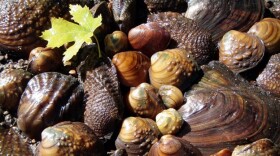Maybe you watched some of the Olympics while sipping a cold IPA, content to be a couch potato while these phenomenal athletes hurled themselves into the air, down a ski slope or over the ice. But Olympic athletes actually share something with your favorite brew.
I really enjoyed watching the cross-country skiing events where it is common to see skiers collapse on the finish line. Is this the skiers’ equivalent of a basketball or a soccer player’s flop, pretending to be injured? Or maybe they are trying to convince their coach they put in an all-out effort? No, that is not what is going on. Those cross-country skiers have run out of oxygen and their muscle cells have filled up with lactic acid which is extraordinarily painful. They are gasping for oxygen to get all the lactic acid to convert to carbon dioxide and relieve them of their pain.
OK. But where does beer come in? First, a primer on some basic biochemistry. Life on earth depends plants, and on a plant’s ability to turn air into sugar. Using some elaborate chemistry, plants pull carbon dioxide out of the air, and in the presence of the sun’s energy and the plant’s chlorophyll, plants make sugar and give off oxygen in a process called photosynthesis. That sugar is then used as the building blocks for all the other compounds that make up the plant. This is the source of food for animal life.
But plants also respire, which is like photosynthesis in reverse. We think of respiration as breathing, but what it is really going on is we are pulling oxygen out of the air to burn our food. There is no actual fire in our gut, but respiration is the process that slowly converts our food into usable energy and carbon dioxide. We need and use that energy to ski and sled and snowshoe, and even to just sit on the couch. Plants do this too – they need to convert all that sugar they made from photosynthesis to grow their roots and shoots and flowers and fruits. Both plants and animals need oxygen to efficiently convert their fuel to energy and the biochemical pathways known as respiration are remarkably similar in plants and animals.
That is, until there is no oxygen around. When an Olympic skier collapses at the finish line, heaving and almost unconscious, their muscles have largely run out of oxygen. Without oxygen, their cells have diverted energy production into an alternate biochemical pathway. They have gone anaerobic – meaning they are burning fuel without oxygen. In animals, that process produces lactic acid. This causes extreme pain in their muscles, hence the collapse at the finish line. It also produces far less energy than the normal oxygen-fueled pathway. But it is better than coming to a complete halt. This anaerobic pathway is called fermentation.
This alternate oxygen-deprived pathway is similar, but deliciously different, in plants and yeast. Instead of producing lactic acid, plants and yeasts deprived of oxygen follow a different set of chemical reactions that result in the production of alcohol and carbon dioxide. Humans have taken advantage of this and have learned to make beer and wine.
Yeast is a kind of fungus and is naturally present as a “bloom” on the outside skin of grapes. Once the grapes are harvested and mashed, the pulp is placed in air-tight containers. The yeast from the surface of the grape and the sugar from the grapes themselves get to work in this oxygen-free environment. Without oxygen, the yeast uses the fermentation pathway that breaks down the sugar into alcohol and carbon dioxide. But the yeast has a limited tolerance for alcohol, and fermentation will stop when that limit is reached. That is why wine usually tops out at about 12% alcohol, and once reached, there is no more fermentation.
To make beer, yeast is added to a mash of malt and barley. Initially, this concoction is shaken vigorously to encourage growth of the yeast in this oxygen-rich environment. Beer-making yeast is clever - it can grow with or without oxygen. But once the yeast uses up all the oxygen present at the beginning of the process, the show goes anaerobic. Now the fermentation starts, that biochemical process that produces alcohol and carbon dioxide. Beer making is pretty complicated, but at its core, there must be fermentation by the yeast, feeding on the malt and barley.
So, even though you may not ski hard enough to collapse on the finish line, your body still might crave that post-ski beer. So drink up, and thank anaerobic respiration for helping some Olympians win a gold medal, while you sit on the couch enjoying a refreshing beer.









